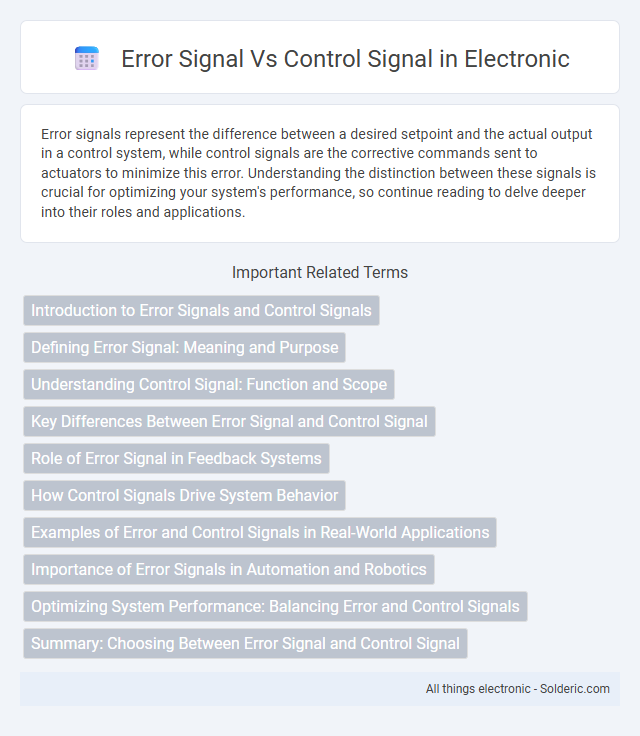Error signals represent the difference between a desired setpoint and the actual output in a control system, while control signals are the corrective commands sent to actuators to minimize this error. Understanding the distinction between these signals is crucial for optimizing your system's performance, so continue reading to delve deeper into their roles and applications.
Comparison Table
| Feature | Error Signal | Control Signal |
|---|---|---|
| Definition | Difference between desired output and actual output | Input sent to a system to adjust its behavior |
| Purpose | Indicates system performance error | Corrects or regulates system output |
| Role in Control System | Feedback component for error detection | Actuating command to control element |
| Source | Derived by comparing reference and actual output | Generated by controller based on error signal |
| Signal Type | Measurement / Feedback signal | Actuation / Input signal |
| Example | e(t) = r(t) - y(t) | u(t) = K * e(t) |
Introduction to Error Signals and Control Signals
Error signals represent the difference between a desired setpoint and the actual output in a control system, serving as a crucial feedback mechanism to detect deviations. Control signals are generated by the controller based on the error signal to adjust the system's behavior and minimize the error. Understanding how error signals drive control signals enables effective regulation and stabilization of dynamic systems in engineering applications.
Defining Error Signal: Meaning and Purpose
The error signal represents the difference between a desired setpoint and the actual output in a control system, serving as a crucial input for system adjustments. Its primary purpose is to indicate how far the system's current state deviates from the target, enabling corrective control actions. You can use the error signal to dynamically tune control signals, ensuring optimized system performance and stability.
Understanding Control Signal: Function and Scope
Control signals manage and regulate the operation of systems by sending commands that adjust the behavior of devices or processes. Their scope includes direct manipulation of actuators, modulating system parameters, and ensuring desired output performance by responding to input commands or feedback. Your understanding of control signals is essential for effective system design and troubleshooting, as they serve as the primary mechanism for steering system actions.
Key Differences Between Error Signal and Control Signal
Error signal represents the difference between the desired setpoint and the actual output in a control system, serving as an indicator of system deviation. Control signal is the corrective command generated by the controller based on the error signal to drive the system toward the target value. Understanding these distinctions enhances your ability to design and troubleshoot effective feedback control systems.
Role of Error Signal in Feedback Systems
Error signals in feedback systems represent the difference between the desired setpoint and the actual output, serving as a critical input for system correction. This signal guides the controller to adjust control signals, minimizing deviations and enhancing system stability. Precise detection and processing of error signals ensure optimized performance and accuracy in automated control mechanisms.
How Control Signals Drive System Behavior
Control signals directly influence system behavior by guiding the operations and adjustments needed to achieve desired outcomes. While error signals represent the difference between actual and target performance, control signals use this information to modify system inputs or processes, effectively steering performance back on track. Your ability to monitor and adjust control signals ensures optimal system stability and responsiveness.
Examples of Error and Control Signals in Real-World Applications
Error signals in real-world applications include the difference between the desired temperature and the actual temperature in a thermostat system, while control signals adjust the heating or cooling mechanisms to correct this discrepancy. In industrial automation, an error signal might represent the deviation of a robotic arm's position from its target, prompting control signals to motors to realign the arm accurately. Your devices rely on these signals to maintain precision and ensure optimal system performance through continuous feedback and adjustments.
Importance of Error Signals in Automation and Robotics
Error signals play a crucial role in automation and robotics by continuously comparing the desired output with the actual output to maintain system accuracy. These signals enable precise adjustments to control inputs, ensuring that robotic mechanisms perform tasks with high precision and reliability. Your ability to optimize system performance depends heavily on effectively processing error signals to minimize deviations and enhance responsiveness.
Optimizing System Performance: Balancing Error and Control Signals
Balancing error signals, which indicate deviations from desired performance, with control signals that adjust system behavior is crucial for optimizing system performance. Effective tuning ensures that your control system minimizes error without causing excessive response oscillations or instability. Proper alignment between these signals enhances accuracy, responsiveness, and overall system efficiency in dynamic environments.
Summary: Choosing Between Error Signal and Control Signal
Error signals represent the difference between desired and actual system outputs, crucial for feedback and system adjustment accuracy. Control signals directly influence system actuators to correct deviations identified by error signals, driving real-time operational changes. Choosing between error and control signals depends on system requirements, with error signals favored for monitoring and diagnostics, while control signals are essential for active system regulation.
error signal vs control signal Infographic

 solderic.com
solderic.com